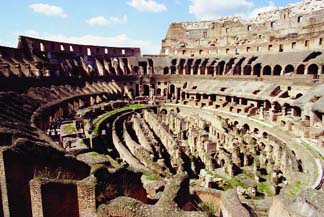
But have you ever wondered, as I did, where all these spectators might have gone to answer nature's call?
Construction for the Colosseum began in 72 AD by the emperor Vaspasian, and was originally known as the Flavian Amphitheater, after the family of the emperor. After his death, his son, Titus, continued construction and dedicated the arena in 80 AD. It acquired the name “Colosseum” after a colossal statue of the emperor Nero was erected nearby. This statue of gilded bronze, reportedly 100 feet high, has disappeared, although you can still see the remnants of the pedestal.
The Colosseum is the largest of the Roman amphitheaters, which were relatively common in the Mediterranean area during the era of Roman rule. Many of these amphitheaters have survived in good condition; in fact, the arenas in Nimes, Arles and Verona are still in use as performance spaces after almost two millennia. (In contrast, the theatres in Lincoln Center in New York City are scheduled for major repairs after less than a half-century, as they are starting to fall apart.)
Where To? You can read a lot about the Colosseum, but not much about where the patrons went to the bathroom. A professor of classic civilizations admitted that, although he had taught the subject for three decades, the question had never occurred to him. Several other scholars gave similar replies.
Eventually, after much searching, some facts and conjectures began to emerge. As anyone who has ever seen one of their aqueducts can attest, the Romans were masters of bringing water to urban areas and distributing it throughout the city.
Archaeologists have found remains of public latrines, which could handle about two dozen clients at one time; there is no evidence that they were segregated by sex, and there was no attempt at privacy. In addition to a hole on top, there was a slot in front where a sponge on the end of a stick could be used for cleansing, after which it was put back in a bucket or trough of water.
These latrines were situated over canals, which eventually emptied into a main sewer (cloaca maxima) and finally into the Tiber. Since Rome, at its height, had more than 1 million residents, these latrines must have been numerous. So few remain today since they were made of marble. After the fall of Rome, many monuments were used as a supply of building materials, and the marble in these latrines probably disappeared rapidly.
The fact that water flowed into the Colosseum is well known; according to some accounts, the arena was flooded on occasion for mock naval battles. Evidence has been found of drinking fountains in various areas of the arena.
Drainage System
There was an extensive system of drain canals below the arena, which were probably used to flush away the wastes from the huge number of animals kept there for use in the games, and also to handle the drainage of rainwater.One scholar notes that there were urinal troughs located in the back corridors behind the seats. Aristocrats may have had slaves carrying chamber pots to take care of their owners' needs. Also, men might have simply urinated discreetly wherever convenient and then returned to their seats.
But this still does not answer the question as to where the great bulk of the spectators could go when they had to go. One reference book went so far as to say that if there had been toilet facilities, a logical place for them would be beneath the box where the emperor sat. Nothing survives, however, to prove or disprove this theory.
The most probable explanation is that there were a number of public latrines located outside the Colosseum, and that these disappeared during the Dark Ages when, as noted earlier, they were plundered for the marble they contained.
However, no archaeological evidence has been found in the area, and the growth of modern Rome probably precludes any extensive excavating in the vicinity of the Colosseum. Besides, the number of scholars who want to dig deeply into this aspect of theatre is no doubt minimal. So we have the mystery of the Colosseum - “Ubi forica es?”
So the next time you enjoy “Gladiator” or “Ben Hur” in the comfort of your home, try to imagine what it must have been like under a hot Roman sun, with the smell of live and dead animals, the nearby latrines, the chamber pots, the urinal troughs, and the cloaca maxima carrying the wastes of a million Romans.
My analysis is that today, things are better.
